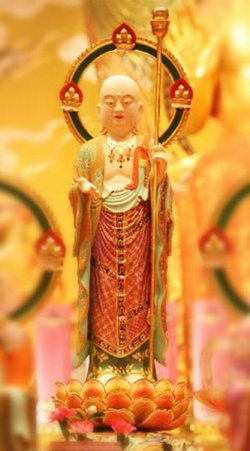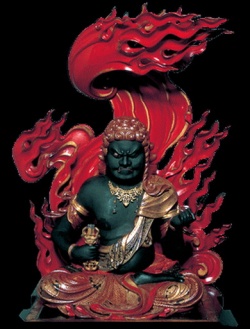Shingon is so cool: Diamond and Womb mandalas-the two faces of Now
The hand moves
The fire's whirling
takes different shapes
All things change when we do.
The first word, "Ah,"
blossoms into all others
each of them is true...
-Kukai -
I want to take this opportunity to talk about mandalas.
Hanging on the wall in Shingon temples, on either side of the sculpture of a Buddha, are two, large, exquisite paintings of mandalas. These mandalas are thought to be blueprints of the “Diamond and Womb Realms,” and they represent, among other things, the masculine and feminine aspect of reality in every moment.
The masculine aspect of each moment is said to be crystal clear Emptiness, appearing as everything, like a multifaceted diamond. Each facet of the diamond is a different universe, or thought, or feeling, or phenomena, all of which are seen as the countless faces of the same crystal clear Emptiness. "Realm" is understood also as "World," and in Shingon Buddhism a world is actually a "world-view" or a perspective. Therefore, these mandalas are illustrations of perspectives we can take, and should take, if we wish to transform our world view.
So, from the perspective of the diamond realm, or from looking through the lens of a diamond mandala, such as in the painting above, everywhere you look you see tiny buddhas,countless buddhas, buddhas of all sorts, in all sorts of realms, all faceted and connected in a diamond-like perfection. (Walking through a forest will often activate this kind of perspective in me, especially if that forest is covered in tiny sculptures and tombs representing infinity, clarity, and light, as is the forest at Mt. Koya, where Kukai is buried. Also, being surrounded by loved ones can activate this kind of perspective. Angels everywhere.
Understanding this "empty nature of reality" directly is known in Buddhism as “Wisdom” or “Prajna.” The practice used to develop and stabilize this wisdom is meditation—sitting still and using the mind to look at the mind. The fruition of the practice is actualizing Emptiness: Crystal Clear Diamond-mind. ("Diamond" also because this mind or realm cannot be changed or scratched by anything.)
The Womb mandala, represents the other side of reality: the feminine. This aspect is the energetic fullness and movement and emerging "becoming" quality of each moment. Every moment is full (not empty!); full of a flowing, flowering, changing energy, and it all comes out of the luminous womb of the present moment. This is the feminine, the movement and dance, the infinite forms and feelings and colors. In this realm, forms are all real and valid, not illusory, and the love of the forms is also real and valid. In-forming this mandala or truth is the path of embrace, of sensuality, and of loving and being totally involved in everything. The practice is Love. The fruition is Fullness, Compassion: Warm Hearted Womb-mind. (Basically, these mandalas can represent Big Mind and Big Heart).
Interestingly, the center or foundation of the Womb realm is a Buddha, a being, a loving, conscious presence. The "center" of the diamond realm, however, is a structure, a grid, a realm, filled with buddhas. Perhaps these two mandalas also represent the personal and impersonal aspects of God(head)? I like to think so. We can also notice that the Womb realm uses central composition whereas the Diamond realm uses more of an overall composition. Also, radial or rotational symmetry in the Womb Realm verses a kind of bilateral symmetry or matrix in the Diamond Realm can convey meaning. Of course, both realms include both kinds of symmetry, as well as a-symetry or chaos, but you can see the overal emphasis in each realm, I think.
In Buddhism it is often said that one cannot have emptiness without form, wisdom without compassion, stillness without movement, timelessness without time. (And remember, it goes both ways: you cannot have time without a timeless.)
We cannot have the One without the Many, and when this is realized, then Emptiness and Form highlight each other as clarity and light (also know as insight), and the union of Emptiness and the entire world of Form appears as the basic and yet also erotic union of consciousness and all of its manifestations in every moment. This "primordial union" is also the ultimate union of the masculine and feminine, and is symbolized by the monk sitting in meditation (masculine), singing and dancing with his hands (feminine), ringing bells, holding vajras, beating drums, and being the movement of the moment, not just its ever-present, empty witness.
"Bliss cognizing Emptiness arises as compassion."
Some important background: Shingon Buddhism (which can be translated as Mantra-yana) is a type of Japanese Vajrayana founded by Kukai 1200 years ago. Kukai was this brilliant artist-scholar who went to China and received the entire tantra and vajrayana teachings (from a lineage going all the way back to Nagarjuna), and brought them back to Japan to be practiced and preserved.
Maybe I should provide a little more background. Over simplified, the world of Buddhism can be divided into three broad stages or levels of practice: Hinayana (small vehicle), Mahayana (great vehicle), and Vajrayana (diamond vehicle). Each one can be seen as a developmental stage, leading the practitioner, step by step, into higher/wider/deeper levels of wisdom and compassion.
Hinayana is the foundation and core practice of all schools of Buddhism. The main exercise is "vippasana" or “insight meditation,” where one sits down and simply gives attention to whatever arises in the space of their awareness. The goal is to see through to the empty nature of all that arises, of all phenomena, including your own grasping, thinking mind, transcend this world, reach nirvana, achieve enlightenment, and become a sage or "arhat."
Mahayana (which was formed hundreds of years after the Hinayana) takes this practice of enlightenment one step further and aims at the enlightenment of all beings, and all worlds. After suffering and self are seen through to be empty, they are embraced (along with the world) and are therefore radically transcended. ("Transcend" to the Mahayanist practitioner now means "transcend and include," not "transcend and get rid of.") This world then appears to be identical to nirvana, just as it is. (The Heart Sutra: “emptiness is none-other than form; form is none other than emptiness”). Then the seeking mind, the last trace of resistance to the timeless buddha-nature that already is, can dissolves into its own self-liberating, energetic, transparent place. The goal for Mahayanists isn’t to achieve nirvana (which, philosophically, cannot be "achieved", for it is the “unconstructed condition”), but the "goal" is instead to become (or express) a bodhisattva. A bodhisattva is one who stays in this world until all beings are awakened. The central practice of the bodhisattva is compassion, and there are actual practices used to cultivate and increase the amount of love and care in the practitioner’s mind and heart.
After Mahayana comes Vajrayana Buddhism (appearing in Japan as the esoteric "mikkyo" or "secret religion"). Vajrayana is based on one uncompromising principal: There is only Buddha Mind. There is only Spirit. There is only Luminous Emptiness in every direction. Vajrayana is the tantric path, embracing all forms of energy, using postures and mantras and visualizations of deities in mandalas to express and manifest already-enlightened mind. And since everything is already Buddha Mind, there is no way to reach Buddha mind, so the practitioner simply learns to play and delight with the mind and body and energy and self, just as they are, in the present moment. Because the Buddha-mind is always already present, there is no future time when it will be "more present,” so a radical release from the seeking mind is facilitated by a total delight and ecstatic love with everything arising in the present moment, whether that be fear, anger, computer screen, or cold feet. The practitioner of vajrayana sees the world as a Buddha would see it, and therefore they suffer as much as they possibly can, They are radically free to be filled with all life; embracing everything as energetic aspects of the Self; the Buddha within.
So, these mandalas are supposed to communicate those kinds of ideas and experiences to the viewer or imaginer (they are truly supposed to be visualized, using the actual energy and ethereal screens of the mind's eye). Do they do a good job?
Maybe there is a kind of re-organization or structure change that occures within the brain and mind when these forms are constructed. One mandala contains hundreds of buddhas, and each buddha is supposed to be visualized as made of pure and endless wisdom and compassion. And in order to visualize that, one would have to cultivate pure wisdom and compassion hundreds of times.
Posted by David


